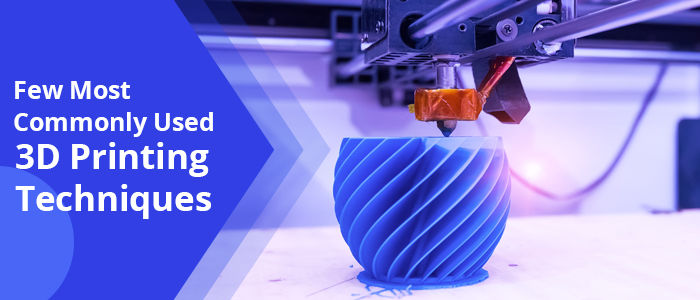Few Most Commonly Used 3D Printing Techniques

3D printing, also known as additive manufacturing is a manufacturing technique that creates physical objects by creating layers in succession, by adding one on top of the other. This technology is very different from the traditional methods of manufacturing like machining or casting. Though the terms 3D printing and additive manufacturing are often used interchangeably, the latter is more commonly associated with industrial applications that also include the serial production of different components. On the other hand, 3D printing is more consumer-focused. The nature of the parts that are made by these two technologies is different. 3D printing is more often used for decorations, figurines, etc, while additive manufacturing is more closely associated with end to use products, produce molds and components.

There are different manufacturing techniques that are used under the 3D printing technology. Let us take a look at four most popular technologies categorized by the International Organization for Standardization (ISO/ASTM 52900):
- Vat photopolymerization: this is also known as stereolithography (SLA). In this process, a liquid is turned into a solid with the help of a light source. This process came to be known as polymerization and this was actually the first industrial additive manufacturing technology. In the early 1980s, SLA was formed by Chuck Hull, who was the founder of 3D Systems. He took this process into the market in 1987. The photocurable resins that SLA uses, hardens when they are exposed to the UV light. This light is usually is a laser beam and it forms the shape of these layers into a vat filled with resin. Once one layer hardens, the build platform moves up or down to allow the new resin to fill in the gap. This process gets repeated for all the layers. The resins used in this process are either epoxy- or acrylate-based. While the former requires more energy to solidify, acrylate-based resins are flexible and they range from tough to rubber-like materials. This process is used to produce detailed and accurate parts. The process micro-stereolithography handles parts that fit on a nanometric scale. This process gives you unmatched precision. The limitation of the SLA process is that it often requires support structures and the post-processing is also a lengthy procedure.
- Sheet lamination: in this process sheets of material are formed together in layers to form a 3D object. The most widely known sheet lamination technology is Ultrasonic Additive Manufacturing (UAM). With the help of ultrasonic waves and mechanical pressure, room temperature metal sheets are bonded under this technique. The sheets are then cut using a laser after or before the bonding. These produce a cross-sectional shape of the layers that when stacked together, form a 3D model. To achieve a better finish, the parts are polished. The other technique used in this process is Laminated Object Manufacturing (LOM) where the adhesive coating is used to bond the sheets. These sheets are heated with the help of a roller and the final parts are extracted from the surrounding object. For UAM, the most common materials that are used are aluminum, copper, stainless steel and titanium alloy. For LOM, A4 paper is used. While UAM is used for building new combination of materials, LOM creates rapid prototyping. This process is fast and cheap but LOM has low part strength and UAM has a lengthy post-processing procedure.
- Powder bed fusion: this process uses a thermal source of energy to fuse particular areas of powdered material. This involves various processes that are commonly used for industrial applications. The first process invented under this technique is known as Selective Laser Sintering (SLS). The powder bed processes take place in a vacuum chamber having inert gas. The chamber is kept preheated and the process begins by spreading a thin layer of powdered material in a platform. Then a thermal source of energy is used to fuse the powder together so that a combination of layers is formed. The process gets repeated until a 3D object gets formed. A wide range of materials can be used to support this process from nylon to metals like stainless steel, titanium alloys and aluminum. With a few additional steps, ceramic materials can also be processed. This is one of the few 3D printing techniques that are heavily used for production parts. Though post-processing is required, industries like healthcare and aerospace are widely making use of these technologies on a regular basis. While this process requires several post-processing steps and it is a costly process, this can use a wide range of materials and the finished products have excellent mechanical properties.
- Metal extrusion: this is the common term used for all additive manufacturing processes where the material gets distributed through a nozzle and forms various shapes. The source material can be any material that can be pushed through a nozzle while retaining its shape. The print head, in this way, moves around drawing a 2D layer by the nozzle. Once the paste-like material gets deposited, it is hardened with the help of cooling or drying. The print head thereafter moves upward to deposit the next layer and the process is repeated until the 3D object is formed. This process is also commonly referred to as the FDM 3D printing of desktops. Technically, you can put any material through the nozzle that can retain its shape. However, the most commonly used materials are clay, concrete, bio-ink and edibles like chocolates. This being a very straightforward process is commonly used for rapid prototyping. The finished parts generally do not require much post-processing and from buildings to bioprinting techniques, this process of 3D printing is used in a wide variety of industries. While this process has low speed and offers low accuracy, being a cheap and straightforward process, it is preferred by many industries.
Though some of the above mentioned 3D printing processes are used in industrial and professional contexts, they still are accessible. If you are looking to benefit from any of these 3D printing techniques, you need to go for a 3D printing service.

